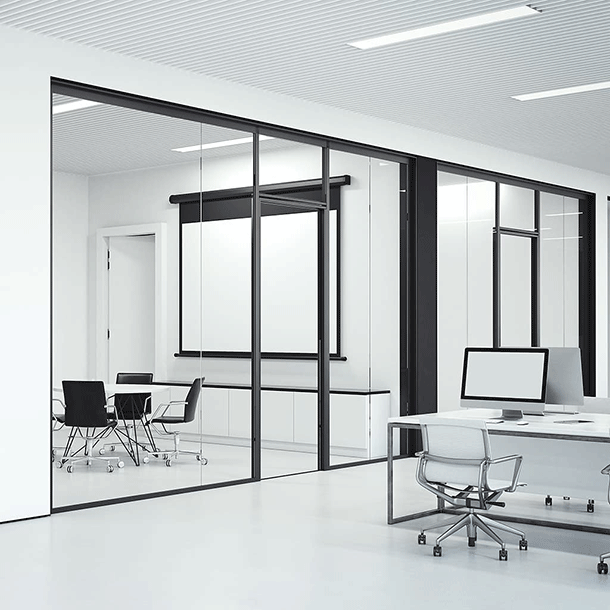Lack of confidentiality can be a problem, but the illusion of confidentiality is worst. This is even more true in the case of private offices, where conversations carried behind a closed door are generally intended to be kept that way, isolated from the rest of the workspace. At Soft dB, we have heard our fair share of not-so-private offices and conference rooms. In most cases, lack of confidentiality is a combination of poor noise isolation, loud conversations, and excessively low background noise levels, all of which are commonly found in typical workspace settings.
Speech Confidentiality and Acoustical Performance of Private Offices
Over the last 20 years, our team of acousticians has led many projects focused on improving the acoustical performance of private, closed offices, in an almost endless number of workspace layouts. We’ve performed a significant amount of on-site building acoustic measurements, before and after various types of architectural modifications. This article highlights the factors having the most impact on the acoustical performance and speech confidentiality of typical private office designs.
Performance Measurements You Should Know
Transmission Loss (TL)
The transmission loss is the attenuation of sound traveling through a partition, such as a wall assembly, a suspended ceiling, a raised floor, or a door. If the sound level is 80 dB on the source side, that is where the sound originates from, and 30 dB on the receiving side of the partition, then the transmission loss of that partition is 50 dB. In other words, the partition “stole” energy from the sound traveling through it, decreasing its intensity level by 50 dB as it reaches the other side.
Sound Transmission Class (STC)
The STC rating is the standard index used to measure transmission loss through partition walls and quantifies the loss with a simple number. The STC rating expresses the amount of dB lost through a partition, which means that, on average, a STC-35 partition attenuates sound by approximately 35 dB. The STC rating is based on third octave bands so the actual calculation is a bit more complex than that.
The STC rating of a partition is generally measured in a lab, which means that, in many cases, it may not accurately reflect the reality of real-life installations where, as you can realistically expect, nothing is ever perfect… And that’s specifically where Apparent Sound Transmission Class, or simply ASTC, comes in play.
Apparent Sound Transmission Class (ASTC)
The ASTC rating is always measured on site, so it includes sound leaks and deficiencies in the partition. For instance, sound can travel through air pockets like ductwork, stud and ceiling joist cavities. It can also be conducted along studs, joists, pipes, concrete and glass. Moreover, sound and noise can also leak through electrical receptacles, switches, outlets, boxes etc.. Because of this, the ASTC rating is almost always lower than the theoretical STC value measured in perfect lab environments. It’s very common to have an ASTC rating that’s 5 points lower than the STC value, but the difference can be a lot more significant in many cases.
Ceiling Attenuation Class (CAC)
The Ceiling Attenuation Class, or CAC, is a standardized measure for rating how well a ceiling system performs at stopping sound transmission through a plenum space shared between adjacent closed spaces, such as private offices. Theoretically, ceiling tiles with a CAC rating of 35 points attenuate the sound traveling through the plenum space by approximately 35 dB. CAC-35 is considered a good performance, while anything rated under CAC-25 is considered low performance.
Measuring Confidentiality Objectively
Speech Privacy Class (SPC)
While speech privacy tends to be a subjective problem, the Speech Privacy Class (SPC) is an objective metric to put a number to it. It was developed by the National Research Council (NRC) and is fully detailed in ASTM E2638, a standard test method providing a means of measuring the sound isolation between the interior of a closed room and locations outside that room, as well as the background noise levels outside the room. The SPC index measures the degree of speech privacy provided by a closed room, for conversations carried inside the room, and with potential eavesdroppers located outside the room.
The SPC rating has an evaluation scale that ranges between 50 and 85 points approximately. The lower the value the less confidentiality, and the higher the value the more confidentiality. Closed offices with SPC ratings below 60 are considered insufficiently confidential. Only offices with SPC ratings above 60 are considered to provide appropriate levels of confidentiality. Finally, closed offices with SPC ratings above 70 are considered to provide excellent levels of confidentiality. In such offices, people can feel comfortable discussing sensitive matters without being overheard outside.
Speech Intelligibility Index (SII)
The Speech Intelligibility Index (SII) measures the ability to hear speech, that is the ability to clearly pick up words being spoken. The SII is a number ranging between 0 and 1, or between 0 and 100%. The SII index indicates the percentage of syllables that can be clearly understood in conversations. A lower SII number means less intelligible conversations, while a higher SII number means more intelligible conversations.
Office Doors Are Not Very Good at Blocking Sound
When it comes to sound leakage, closed-door conversations behing overheard, and general lack of confidentiality, the door assembly is always a weaker link among the weakest in the acoustic performance of a closed office. Is it really surprising?
Office doors typically have ATSC ratings between 20, for cheaper, less isolated doors, and 40 points, for more expensive, better soundproof doors. It’s actually quite rare to find a door delivering a performance higher than ASTC-40. The average gypsum wall has an ASTC rating between 40 and 55 points, which makes it inherently more effective at blocking sound than most doors available on the market. In fact, even glass walls perform generally better than doors, regardless of quality. Your private office doesn’t feel so private afterall? The door, more often than not, is a rightful culprit.
The image below shows a sound intensity mapping of a closed office front wall assembly, consisting of a glass wall and a soundproof door. As you can see, 90% of the sound energy, the red highlighted area, is leaking through the door threshold.
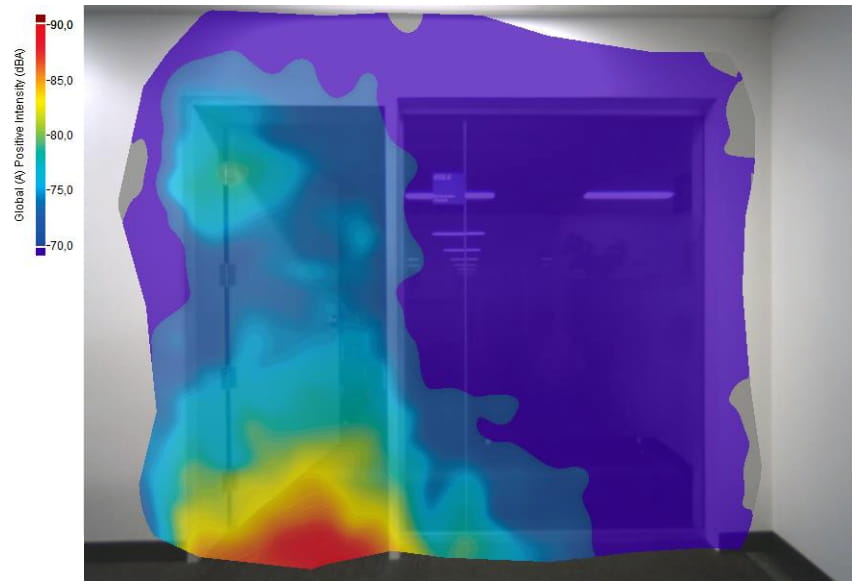
Sliding Doors Perform Even More Poorly At Keeping Things Private
If one of your goals is to ensure a minimum level of speech privacy and confidentiality, sliding doors, although aesthetically pleasing, should be avoided. With a relatively low ATSC rating varying between 20 and 25 points, eye pleasing (and perhaps, functional?) is all sliding doors really are in terms of acoustic performance. They’re simply not intended, nor designed to block sound. Conversations carried behind sliding doors will most likely be heard by anyone standing outside the closed office space.
When confidentiality of the space is important, ATSC-30 is considered a bare minimum rating. And in order to achieve such rating, you shouldn’t consider anything else than sound resistant doors, let’s call them acoustic doors, with STC ratings of 35 or more and quality airtight seals all around. Meanwhile, keep in mind that even the highest STC-rated door won’t perform as expected if its bottom threshold performance doesn’t match up. That’s right, you’re often better off with a well-installed STC-35 door than some poorly installed STC-50 door with improperly bedded threshold.
Sound Transmission Through Open Plenums and Raised Floors
In suspended, lay-in ceilings with open plenum space or raised access flooring systems, the main path of sound transmission from one office to another is often through the plenum or floor space, that is the empty space between the structural ceiling and the dropped ceiling or under the raised floor.
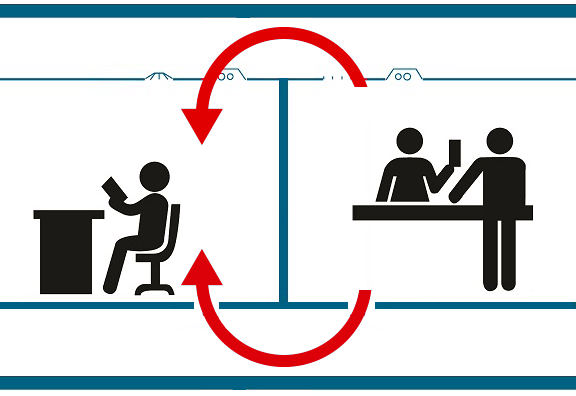
In open plenum designs, the acoustic performance is mostly defined and limited by the transmission loss of the ceiling tiles, in other words, the CAC rating of the tiles. Ceiling tiles have CAC ratings that range between 20 and 40 points (approximately 20 to 40 dB of transmission loss). The average CAC rating of most ceiling tiles is around 30. So even with very well isolated walls, you only achieve an overall ASTC rating as good as the less performing ceiling tiles used, which is around 30. That’s why we strongly recommend using high-performance acoustic ceiling tiles, with a CAC rating of minimum 35 points, but 40 points ideally.
Raised Access Floors Are Good but Not Perfect
Raised access floors are less problematic because the floor assembly tends to have a much higher transmission loss. Indeed, raised floors typically provide greater sound isolation than is possible with standard wall systems or ceiling systems. But they aren’t perfect. Just as with a closed office on a concrete slab, some sound will always travel from one office to another along the floor and under the partition. Sound that penetrates a partition in a typical floor-partition assembly will also enter the floor, travel through it, and break out in the adjacent office, thus partially bypassing the partition. We call that “flanking transmission”. In conventional construction, concrete slabs and wall/floor intersections are well-known flanking paths for sound transmission.
That being said, the main potential issue with raised access floors lies in their air diffusers. The design of the diffusers is critical to minimizing sound transmission, and you don’t necessarily have much control over this. In order to minimize sound transmission through the raised floor’s air diffusers, especially when office-to-office privacy is a concern, the diffuser’s air input openings should be facing away from each other, whenever possible.
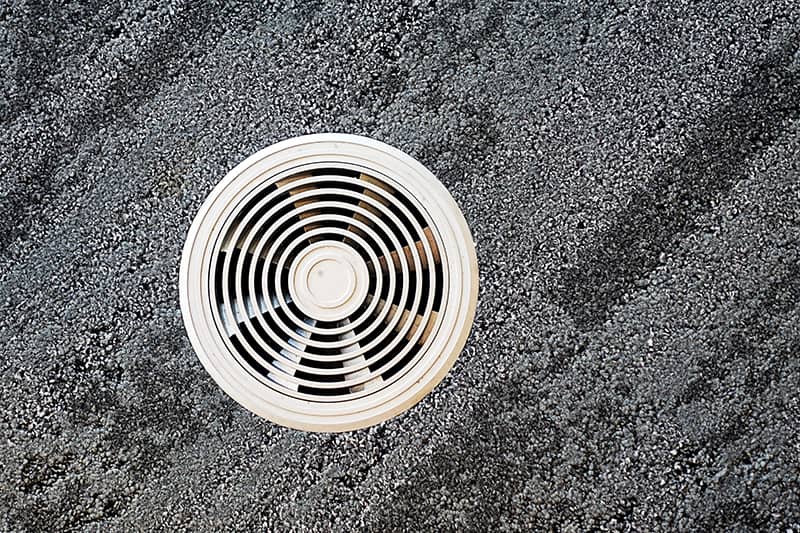
How to Quantify Confidentiality Using the Speech Privacy Class
The Speech Privacy Class (SPC) rating is calculated by summing the raw averaged Transmission Loss (TL) of a partition and the average Background Noise (BG) at the receiver point, that is the average amount of background noise heard by the people standing just outside a closed, private office or on the other side of a wall.
SPC = TL(ave) + BG(ave)
In other words, if you have 30 dB of average transmission loss + 30 dB of average background noise level, you have a Speech Privacy Class of 60 points. If you have 5 dB of average transmission loss (like your office walls are made out of thin, cheap cardboard…) + 55 dB of average background noise level (your cardboard office sits in the middle of a busy open floor plan), you still have a Speech Privacy Class of 60 points. Simple enough, right?
So what is considered a good Speech Privacy Class rating? What is considered confidential enough? In 2009, the National Research Council Canada has developped an evaluation grid for the confidentiality of conversations based on the SPC rating. The table below presents speech privacy qualifiers that are based on NRCC’s evaluation grid, which, in turn, is based on the privacy requirements of office spaces.
Suggested SPC rating evaluation grid
| SPC Rating | Description | Confidentiality |
|---|---|---|
| SPC < 60 | Speech expected to be frequently intelligible (more than once a minute); and almost always audible. | Insufficient |
| 60 ≤ SPC < 65 | Brief phrases expected to be occasionally intelligible (at most once every minute); speech sounds usually audible. | Sufficient |
| 65 ≤ SPC < 70 | Brief phrases expected to be rarely intelligible (at most once every 3.5 minutes); speech sounds frequently audible. | Good |
| 70 ≤ SPC | Speech expected to be essentially unintelligible (brief phrases intelligible at most once every 15 minutes); speech sounds occasionally audible (at most once every minutes). | Excellent |
A Quiet Office Is Good, but Not Too Quiet
There is such thing as “too quiet” in an office. Ever heard of the “pin drop syndrome”? It occurs when your workplace is so quiet that you can hear coworkers breath, and the subtle noise produced by a pin dropped on the floor becomes a loud distraction in itself… That’s right, the office is so quiet that the slightest sounds seem too loud. Now, just imagine a private, sensitive conversation carried in a closed office, door fully shut, but in the middle of a dead quiet open floor plan where the sound of a dropped pencil immediately grabs everyone’s attention. Just how private this conversation really is?
Forget about colleagues eavesdropping outside the door. The real issue here is more likely to be the door whispering out secrets to colleagues trying to mind their own business at their workstations… In the midst of the perfectly silent open office, that private, sensitive conversation is the only thing to be heard, and surely grabs everyone’s attention, whatever they’re focused on. Background noise, or lack thereof, matters… a lot actually.
More Background Sound Means More Confidentiality
So it comes as no surprise that the Speech Privacy Class (SPC) rating correlates directly with the amount of background noise measured in a space. Indeed, the background noise level is a key factor of confidentiality, at least equally as important as the actual architectural sound transmission loss. Meanwhile, architects and interior designers tend to focus almost exclusively on the architectural sound transmission loss, paying extra attention to the STC rating of building components, while all too often overlooking the background noise factor. Yet in many scenarios, controlling the background noise level in a space is much easier than maximizing the STC ratings of its partitions.
For instance, in order to increase confidentiality by 10 points, you can either increase the architectural performance by 10 points, which can be difficult and expensive, or increase the background noise level by 10 dB, which can be more easily achieved through the use of a sound masking system.
In one of our recent office acoustics projects, we measured a background noise level around 38 dBA with occupants in the space, and more or less 35 dBA when the space was completely empty. That’s a very quiet office, as in “library quiet”. As discussed earlier, having such little background noise leaves us solely relying on the STC ratings of architectural components to achieve appropriate confidentiality. However, it would be rather easy to artificially increase the background noise level to 42-43 dBA, without even compromising on the acoustic comfort of occupants, and achieve a notable improvement in speech privacy and confidentiality. And that’s specifically what sound masking masking is all about.
Using Sound Masking to Achieve Slightly Higher Background Noise Levels… and Much More!
One of the main ideas behind sound masking is to even out the quiet throughout the office space by increasing the background sound level just enough to muffle nearby conversations, without this little extra background sound becoming a new source of distraction in itself. Remember the “pin drop syndrome” mentioned earlier? An environment that’s so quiet that even the slightest sounds become attention grabbers? A sound masking system is designed to drown out such incidental attention grabbers, with the added benefit of generating a perfectly engineered sound spectrum that does all the following:
- Matches and masks out critical frequencies of speech without adding unnecessary background noise at higher frequencies (which could make things sound pretty harsh, similar to a TV’s loud static noise, and we definitely don’t want that!)
- Is carefully tuned to ensure that there are no jumps from one frequency to the next, which helps keep the room occupant’s perfection of the sound to a minimum.
- Takes into account the existing ambient noise level of the space. Instead of simply “adding extra noise” to the environment, it automatically calculates what the existing spectrum is and seamlessly fills the gaps to bring it up to the most comfortable sound curve. Because of this, sound masking may actually make the office space “feel quieter”, by taming harsh peaks at certain frequencies from ventilation systems, air conditioning and other office equipment.
- It can be tuned and optimized for each individual location within the workspace. Indeed, existing background noise levels will always vary slightly, sometimes even by a great deal, across the workspace and within closed, private offices. And since no two spaces are entirely alike, good sound masking systems make it easy to measure the baseline noise level at every location and smooth it out as needed.
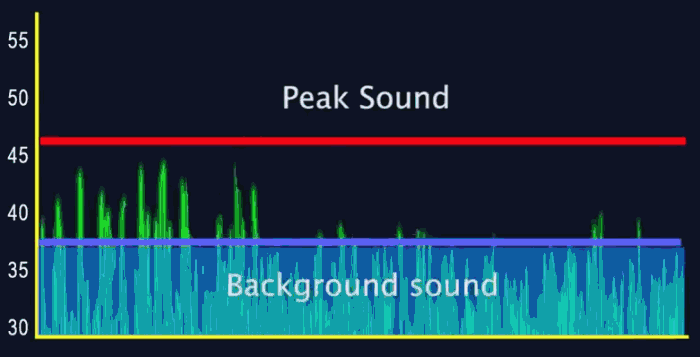
How Sound Masking Helps You Achieve Higher STC Ratings
While sound masking doesn’t technically increase the ASTC rating of walls, it still significantly improves speech privacy, which is ultimately what we wish to achieve by increasing the ASTC rating in the first place. Therefore, it’s reasonable to say that improving speech privacy, no matter how we succeed, is the equivalent of a higher ASTC rating.
Of course, the exact equivalent increase in ASTC rating achieved with a sound masking system depends on various factors, but is between 5 and 10 points in most cases. Simply put, adding sound masking in a closed office is pretty much the same thing as increasing the ASTC ratings of this office’s walls, ceiling and door by 5 to 10 points.
The SPC rating clearly shows the significant impact of background noise levels on confidentiality. Increasing the background noise level from 5 to 10 dB will increase the SPC rating by 5 to 10 points, without increasing the sound transmission loss of any architectural component. You now have a higher SPC rating without having spent a dime on ticker walls, better soundproof doors, or ceiling tiles. More importantly, you are achieving better confidentiality with less construction materials. If environmental sustainability matters to you, isn’t that excellent news? Less waste, less dust, less potential disruption caused by messy, noisy construction work. Indeed, improving the confidentiality of private offices through increasing the background noise level is the most cost-effective option, one that can be leveraged at any stage of a workspace design project, as opposed to maximizing the ASTC ratings of partitions, which in order to yield the desired results, needs to be carefully strategized at the very beginning of the project.
Sound Masking Is Cheaper and Simpler Than Soundproofing
With all that in mind, one of the key benefits of sound masking systems is that they cost much less to install and maintain than increasing the ASTC performance of walls, floors, and doors. Sound masking systems can be fully installed and commissioned in a matter of hours, not days, without even disrupting office activities. Sure, it involves installing loudspeakers and controller units in the ceiling (in larger installations, sound masking controllers are often installed in a centralized network or electrical room), running speaker and network cables, and possibly interfacing with your existing paging/background music systems (because a good sound masking system can also play background music and paging announcements when needed). However, as far as complexity, costs, and the need to coordinate various project disciplines upfront go, none of the latter compare to physically optimizing the acoustical performance of office partitions. Integrating a sound masking system is simpler than soundproofing an office, period.
Sound Masking at Work in Your Typical Office Space
The data contained in the table below is taken from a real-life scenario, one of the many office spaces we visited to improve confidentiality. It clearly shows how adding sound masking to a space contributes to a higher SPC rating. In our example, the background noise measured on-site at 38 dBA has an average dB value of 28 points. That’s pretty much your average office space at rest, where the background noise is mostly generated by heating, ventilation, and air conditioning.
And just like many similar closed offices, we’re dealing with a standard wall assembly, door included, with a transmission loss (TL) of about 30 points. Therefore, based on the simple formula shown earlier, that is SPC = raw averaged transmission loss (TL) + average background noise (BG), our SPC rating here is 28+30=58 points. That’s 2 points under the minimum STC rating to be considered sufficiently confidential… Now let’s add sound masking in the mix to increase the background noise level by 7 points, up to 43 dBA (The neutral and homogenous sound generated by a sound masking system is always truly optimal between 43 and 48 dB, and such levels are still considered, by any standard, as acoustically comfortable for the workspace occupants).
So as you can see below, increasing the office background noise level to 43 dBA improves the private office’s SPC rating by 7 points. The private office now has an STC rating of 65 and is considered confidential enough, without even having tried to better soundproof it. Used wisely, background noise is a powerful ally for confidentiality indeed… and sound masking is also about transforming this background noise into a soothing sound that goes virtually unnoticed, except for the relief it provides.
SPC ratings with and without sound Masking
| Receiver Room | SPC without sound masking (35 dBA) | Evaluation | SPC with sound masking at 43 dBA | Evaluation |
|---|---|---|---|---|
| Corridor | 28+30=58 | Insufficient | 35+30=65 | Sufficient |
What’s Important to Remember Here?
If the confidentiality of your private offices is a source of concern, and the background noise level of your office, at complete rest, is 43 dBA or less, you should consider sound masking before spending extra dollars on soundproofing existing structures. However, good soundproofing, right from the beginning of construction, remains very important in achieving superior confidentiality and acoustic comfort.
And while the right sound masking system will surely give you an edge in improving occupant wellness, focus, and productivity, it won’t get you the higher confidentiality levels you’re aiming for on its own. In terms of speech privacy, the best sound masking system out there will only perform as good as the architectural elements you choose to integrate in your office designs. The CAC rating of your ceiling tiles, the ASTC rating of your partitions, the quality of your doors… keep in mind that your private offices will only preserve confidentiality as much as their weakest links.
And remember that sound masking is designed to work in synergy with the acoustic environment where it’s installed. For instance, our experience tells us that sound masking works best when high-performance acoustic ceiling tiles are used in the office zones covered. Without such ceiling tiles, or at least some acoustical clouds providing some sound absorption, the sound generated by the system may reverberate throughout the space, and the sound masking won’t accomplish its purpose.
Building on Our Client’s Success
Everything covered in this article has, in one way or another, been observed throughout hundreds of office build out and redesign projects, many of which sharing similar architectural acoustics conditions as used in our examples. A large portion of our international client base, many of which are highly successful Fortune 500 companies, became recurring clients who now systematically recognize the benefits of integrating sound masking technology right at the design stage of their new office projects, not only to ensure proper confidentiality but also to reduce noisy distractions, as well as provide employees with more opportunities for privacy and focus. We’re proud to say that all our clients understand how a comfortable office positively impacts employee mood, drive and performance.


